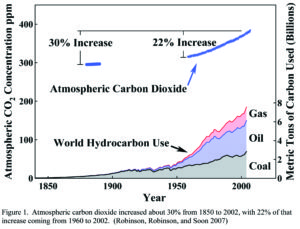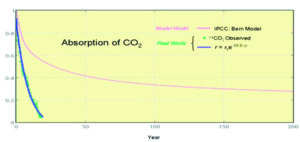
The theory that humans are significantly changing the Earth”s climate by burning fossil fuels has suffered a thousand deaths, only to rise again like the Phoenix because too many see the political possibilities from a “planetary emergency.” Never mind that there is no emergency or even real scientific concern about an advertised “catastrophe.” As the former President of the US National Academy of Sciences, Dr. Ralph Cicerone, once said “We don’t have that kind of evidence.”
Yet the mainstream media continue to hawk “catastrophe” as “settled science,” based mostly upon slight planetary warming over two of the last seven decades that can be vaguely correlated with rising atmospheric carbon dioxide. Never mind that natural climate variations easily explain all robust observations. We live on a fluid planet with vast oceans and atmosphere that are never in equilibrium. That alone guarantees substantial climate variations.
But what about the assertion that we are driving up atmospheric CO2 levels significantly? Is that true? To raise this issue is to invite a howl of protest, because it is soo fundamental to Global Warming theory and so obvious to many. Perhaps for that reason alone, we need to question it. The great physicist Richard Feynman said: “Science is a belief in the ignorance of the experts.”

Figure 1 shows the basic facts, as most understand them. Increasing world hydrocarbon use roughly correlates with increasing atmospheric carbon dioxide. The saw-tooth curve shows the modern CO2 measurements from high up on Mauna Loa in Hawaii. Figure 2 shows much more detail. These are considered to be the best measurements of well mixed atmospheric CO2.

But wait. Humans emit about 9 Gigatons of carbon (GtC) into the atmosphere every year. Yet we only measure an increase of about half that on Mauna Loa. What happened to 4.5 Gt? If you put $9,000 in your bank account and only $4,500 shows up on your bank statements, you would demand an accounting. That is exactly what a few scientists are beginning to do with CO2, demand an accounting.
The Case of the Missing CO2
We have a full-fledged mystery on our hands. Man-made carbon dioxide cannot simply vanish. It has to go somewhere. Yet, once mixed into the atmosphere above the surface, it has essentially no way of leaving, because it is a very stable. Hence, we are told that it remains for centuries. That means that the gallon of gas you burned getting to work today will haunt mankind for centuries. You should be ashamed of yourself!
This cannot be true, because we know that half of the CO2 from that gallon vanished almost instantaneously. Who is the thief? The simple answer is Mother Nature with her vast biosphere and oceans eager to absorb our CO2, because the present concentration in the atmosphere is very low by geological standards and far below what plants crave.
Carbon dioxide that is mixed higher in the atmosphere can easily mix back down, because it is about 45% heavier than the major atmospheric constituents, nitrogen or oxygen. Once near the surface, it readily leaks into the biosphere and oceans.
Happily, we can test the hypothesis of long residency put forth by the United Nations Intergovernmental Panel on Climate Change (UN IPCC). The atmospheric nuclear testing in the 1950s and early 1960s produced a significant amount of radioactive carbon-14 that we have watched leak out of the atmosphere since the Nuclear Test Ban Treaty of 1963. Half disappeared in about seven years.
Figure 3 shows that the United Nations politicians pretending to be scientists have no idea what they are talking about. Their hypothesis of a long residency is wrong.

The Simple Explanation
Although one might suppose that the explanation for this behavior would be complex, it is really very simple. “Elementary, my dear Watson.”

The sleuths this time are atmospheric scientist Professor Murry Salby and theoretical physicist Dr. Ed Berry. Salby has championed the explanation for several years but faced substantial setbacks when he was forced out of tenured positions at the University of Colorado, Boulder and Macquarie University in Australia, probably due in large measure to his willingness to challenge prevailing climate paradigms. Several of Salby”s fascinating lectures are available on YouTube.
Ed Berry took up the challenge of presenting and extending Salby’s ideas, including addressing critics. And since Berry is retired, the Climate Cartel cannot get him fired.

At the recent American Meteorological Society meeting in Phoenix, Berry argued that atmospheric CO2 levels behave much like water levels in a lake or river. If there is a man-made source (like water released from a dam), it will raise the river level downstream. But the water spilled will make its way further downstream and eventually into a larger body of water like an ocean. If the input continues for a long time, the river will establish a new equilibrium level slightly above the water level before release. Because most of the released water flows downstream rapidly, little is left to elevate the river level. Quantitative estimates from Berry’s mathematical model fit the carbon-14 data perfectly.
To watch a real life river analog in action, just go to Bonneville Dam on the Columbia River. On a hot summer day, the Army Corps of Engineers releases vast amounts of water to generate electric power for our region. But the river level below the dam does not rise appreciably, because the Lower Columbia readily spills into that vast reservoir called the Pacific Ocean.
Similarly, man-made or natural carbon dioxide emissions into the atmosphere quickly flow into the other larger reservoirs on this planet, including the biosphere (plants) and the oceans.
Furthermore, Salby points out that the great increase in human emissions of CO2 (more than tripling the rate of increase), beginning in about 2002 as China built many new coal-fired power plants has not caused any visible change in the linear growth of atmospheric CO2. Figure 4 shows how human emissions changed significantly in 2002. Yet Mother Nature shows no response at all in Figure 2.

Figure 4. The substantial acceleration in human emissions of CO2, beginning in 2002. Salby 2015
Salby is likely correct that the linear growth in measured atmospheric CO2 is caused by the slow rise in Sea Surface Temperatures (SSTs), a powerful driver of both climate and CO2.
The inescapable conclusion is that our worldwide CO2 emissions are simply too minor to significantly influence the growth of atmospheric CO2. That also says that reworking Western Civilization to decrease human emissions will meet with complete and utter failure. Mother Nature simple does not care what we do. And with little man-made CO2 remaining in the atmosphere, there is no way to argue that it is having a significant impact on global temperature.
The Details
The atmosphere as a whole contains about 800 GtC; the surfaces of the oceans contain about 1,000 GtC; vegetation and soils contain 2,000 GtC; and the intermediate and deep oceans contain 38,000 GtC. Each year, the ocean surface and atmosphere exchange an estimated 90 GtC; vegetation and the atmosphere about 100 GtC of carbon; marine biota and the ocean surface about 50 GtC; and the ocean surface and the intermediate and deep oceans about 40 GtC. All of these numbers are greatly larger than the human contribution of 9 GtC. In fact, the human contribution is less than the uncertainty in our knowledge of the natural exchanges. (1Gt = 10exp15 grams = 10exp12 kg = one billion metric tons).
Gordon J. Fulks is a Director of the CO2 Coalition and holds a doctorate in physics from the University of Chicago’s Laboratory for Astrophysics and Space Research. He lives in Corbett and can be reached at gordonfulks@hotmail.com.
No Comments
Leave a comment Cancel